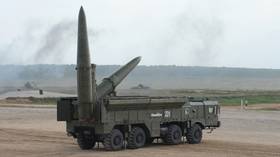Freight turnover via Russia-China bridge booming – official

The volume of freight transported via a highway bridge connecting the Russian city of Blagoveshchensk and China’s Heihe has more than doubled in the space of a year, according to the governor of Amur Region, Vasily Orlov. The official shared the figures at the Eastern Economic Forum (EEF) in Vladivostok on Monday, during a meeting with Russian President Vladimir Putin.
Traffic on the 1,080-meter highway across the Amur River was opened in June 2022. Construction of the bridge began simultaneously in Russia and China in late 2016. The opening of the infrastructure was initially planned for November 2020, but was postponed due to the Covid pandemic.
“With the opening of a permanent checkpoint, we expect a gradual increase in freight traffic to the planned 4 million tons per year,” Orlov stated, as quoted by TASS.
The regional government told the news agency that China is the main trade and economic partner for Amur Region, accounting for 60% of the total foreign volume of trade in the first half of 2023. The operating capacity of the highway is currently up to 190 units of freight transport per day.
The bulk of Russian exports to China via the bridge are non-resource, non-energy exports, such as soybeans and processed products, grain crops, wood products, natural food additives,and coal. The Chinese side supplies equipment, vehicles, consumer goods, vegetables, and fruits to Amur Region. In the first eight months of this year, over 35,000 vehicles crossed the bridge, which is 3.5 times more than in 2022, TASS reported.
The rail section of the bridge opened in November 2022, and Russian trains have since carried more than 1.6 million tons of cargo to China via the link. In July, the first Chinese cargo train arrived in Russia via the new bridge. Checkpoints are now operating round-the-clock, allowing a significant increase in traffic.
In 1995, Russia and China signed an agreement to jointly construct a bridge across the Amur River. In 2015, the two sides amended the agreement by signing a protocol that the governments of Amur Region and China’s Heilongjiang Province would share the costs of the project’s construction and set up a Russian-Chinese joint venture.
For more stories on economy & finance visit RT's business section












